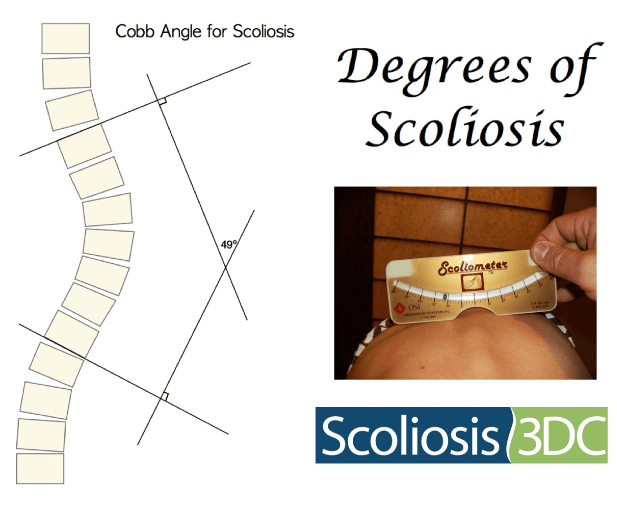Scoliosis Angle – What is the Difference Between the Cobb Angle and Scoliometer Measurement?

Patients and parents often confuse the measurements that doctors use to evaluate scoliosis, specifically Cobb angle and Scoliometer. These scoliosis angle measurements are very different. Both are used by doctors to monitor scoliosis and to determine whether scoliosis is improving (yes, this is possible with the right protocols), maintaining, or getting worse. Hopefully, this post will clarify the ‘degrees of scoliosis’ by explaining these two methods of scoliosis assessment.
Cobb angle is measured from a full-spine x-ray and indicates the degree of lateral curvature of the spine. When an x-ray is taken, your doctor will receive a radiology report, most likely noting the Cobb angle measurements and the location of the most prominent spinal curves. Your doctor will also measure the x-ray as well to determine his own number(s). This isn’t because he doesn’t believe the radiologist but because Cobb angle measurements tend to be subjective measurements. This is due to the fact that each physician chooses the two most tilted vertebra to measure from. This is where the subjectivity comes in. The angle formed at the intersecting point is the degree of that particular curve. For every scoliosis, there will be more than one Cobb angle measurement since there is never just one curve with scoliosis. Usually, doctors report the highest measurement when there is one primary curve, or the two highest measurements when the patient presents with a double curve.
Scoliometer™ (photo, above right) measures scoliosis rotation, also known as vertebral rotation, or angle of trunk rotation (ATR). The scoliometer is a small instrument that resembles a miniature level. Like Cobb angle, scoliometer is also reported in degrees so this can be confusing for parents and patients who are new to scoliosis. Some professionals claim there is a correlation between Cobb angle and scoliometer. One paper, cited below, states that the scoliometer reading can be converted to Cobb angle within 6º. However, in clinical practice, we have found that there are numerous exceptions. It is possible to have mild scoliosis (Cobb angle 10º- 25º) with a high degree of rotation, or severe scoliosis (Cobb angle 50º degrees plus) with minimal rotation for a curve of that magnitude. As an example, one of our patients presented with 80° Cobb angle and only 8° rotation, another patient had a 35° Cobb angle with an ATR of 14 degrees. Still, another presented with a very mild Cobb angle of 14° but a rotation of 7º. We could go on. The point is that each case of scoliosis is unique, resist drawing conclusions based on scoliometer alone. The Scoliometer™ reading is not always an accurate predictor of Cobb angle but can be used between x-rays to monitor the spine.
Although the Cobb angle and scoliometer do not always in correlate as others have suggested, any increase in rotation from one check-up to the next will likely indicate a progressive scoliosis. When this happens, another x-ray is usually necessary. On the flip side, if/when ATR/rotation decreases that’s a good indicator that scoliosis may have stabilized or improved. We check our patients’ Scoliometer™ readings regularly. Scoliometer™ allows patients to avoid unneeded X-ray exposure but still have an indication that they are making progress. There are also scoliometer-type apps that help measure scoliosis at home. However, we don’t recommend that parents get too fixated on doing this to their child. It’s always best when the same practitioner measures as they will know the exact vertebral location of previous measurements. This will allow for more consistent results.
Korovessis PG, Stamatakis MV. Prediction of scoliotic Cobb angle with the use of the scoliometer. Spine. 1996 Jul 15;21(14):1661–6.

